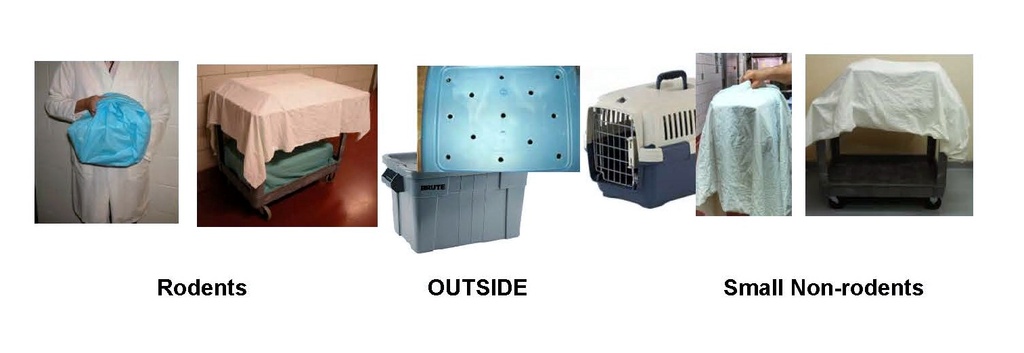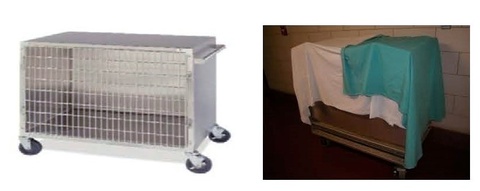Breadcrumb
- Home
- Office of the IACUC
- Policies, Guidelines and Informational Sheets
- Transportation of Animals (Policy)
Transportation of Animals (Policy)
Main navigation
- IACUC Contacts
- IACUC News
- IACUC AnShare ListServ
- Animal Protocol
-
Policies, Guidelines and Informational Sheets
- Anesthesia (Guideline)
- Analgesia - Buprenorphine ER (Informational Sheet)
- Analgesia (Guideline)
- Biologic Testing - Guidance and Procedures for Rodent Biologic Testing (Informational Sheet)
- Blood Collection (Guideline)
- Breeding - Rodent Breeding Colony Management (Policy)
- Enrichment - Canine Enrichment and Exercise Program
- Enrichment - Environmental Enrichment Program
- Euthanasia (Guideline)
- Euthanasia - Confirmation of Death (Policy)
- Euthanasia by OAR Personnel (Policy)
- Genotyping - Mouse Toe Clipping (Policy)
- Genotyping - Rodent Tail Snipping for Genotyping (Policy)
- Hazardous Agent Containment (biohazards, chemical hazards, & radioactive materials)
- Humane Intervention Points (Guideline)
- Media - Social Media (Policy)
- Media - Media Security (Policy)
- New Weanling Procedure for Labs (Guideline)
- Outbreak - OAR Pathogen Outbreak Control Plan
- Pain Recognition in Laboratory Animals (Informational Sheet)
- Principal Investigator Eligibility for Animal Protocols (Policy)
- Social Housing of Species (Policy)
- Sterilization - Accepted Methods & Monitoring (IACUC Guideline)
- Substance Administration - Recommended Volumes (Informational Sheet)
- Substance Administration - Use of Drugs and Chemicals in Laboratory Animals (Guideline)
- Surgery - Non-Survival Surgery (Guideline)
- Surgery - Rodent (Mouse & Rat) Survival Surgery (Guideline)
- Surgery - Rodent Blood Loss (Informational Sheet)
- Surgery - USDA Covered Species Survival Surgery (Guideline)
- Surgery - Xenopus Oocyte Harvest (Guideline)
- Training Requirements for Personnel on an Animal Protocol (Policy)
- Transportation of Animals (Policy)
- Xenopus (Policy)
- Zebrafish (Policy)
- Personnel Training
- Educational Materials
- NIH Grant Information
- Occupational Hazards Associated with the Care and Use of Laboratory Animals
- DEA Information
- New Faculty/Recruitment
Animal Transportation Policy
Policy: The IACUC has provided a set of guidance documents (Policies, Guidelines, and Informational Sheets) for use when planning animal procedures at the University of Iowa. An exception to a Policy must be described and justified in the Animal Protocol and approved by the full IACUC at a convened monthly meeting.
Purpose: The purpose of this policy is to describe approved methods for transportation of animals between the University of Iowa housing facilities and laboratories. All animal transportation must be performed by Office of Animal Resources (OAR) personnel or the laboratory personnel listed on the IACUC approved Animal Protocol. Animals cannot be transported into patient areas without prior approval.
NEVER LEAVE THE ANIMALS ALONE/UNATTENDED outside of a secured animal housing facility or laboratory
Transportation of animals between the University of Iowa Animal Facilities and other Research Facilities
- Prior approval for the transportation and transfer of animals between both units must be obtained
- Please contact OAR (319) 335-7985 for details on how to arrange movement of your animals
Transportation of animals or animal caging outside of an OAR animal housing facility
Rodents & Small Non-rodents
- A maximum of two cages/carriers per person may be hand carried; Larger numbers of cages or carriers should be transported using a cart
- Rodent cages may not be stacked more than 2 high
- Non-rodent carriers may not be stacked
- Check doors of carriers to ensure they are secured by pulling on the door before exiting the housing room
- To exit the animal housing facility, the cages/carriers must be:
- Covered using a clean breathable drape or similar material, OR
- Placed in a breathable, opaque, ventilated container
- A maximum of two cages/carriers per person may be hand carried; Larger numbers of cages or carriers should be transported using a cart
- Movement outside of buildings may only be performed if no interior route is available
- If transporting outside of buildings, cages/carriers must be:
- Cage tops must be secured via an OAR approved method
- Ex: lid secured with binder clips or rubber bands
- Cages must be placed in a breathable, opaque, ventilated, sanitizable secondary enclosure; such as a plastic tub with a lid and air holes
- Cage tops must be secured via an OAR approved method
- Carrier must be secured with a sturdy secondary latching mechanism
- If transporting outside of buildings, cages/carriers must be:

Larger Animals
- Animals should be transported inside a wheeled transport
- At least two people per transport must be present when loading, moving and unloading the transport
- Wheeled transport must be secured with at least two sturdy latching mechanisms on each opening (examples: Carabineer clips or electrical ties (with scissors to remove))
- Doors should be checked to ensure they are properly locked by pulling the door
- Wheeled transports must be covered using a clean breathable drape or similar material
- Wheeled transport must be sanitized between animals
- Movement outside buildings may only be performed if no interior route is available and must utilize an IACUC inspected motor vehicle that is temperature controlled

Transportation of animals between two different University of Iowa Campus locations (East Campus, West Campus and UI Research Park)
- Movement between two campus locations must be requested through OAR by submitting a transfer slips/requests completed to document the animal movement
- Contact OAR (319) 335-7985 for details on how to arrange movement of your animals
- A fee may be incurred if the animal movement is outside of the scheduled route
- Contact OAR (319) 335-7985 for details on how to arrange movement of your animals
- An IACUC approved and temperature controlled motor vehicle must be used for transportation
- Use of an OAR motor vehicle must be reserved in advance
- Use of a non-OAR motor vehicle must be approved by the IACUC
- Cages, carriers and wheeled transports must be secured while in the motor vehicle
- Wheeled transports may require strapping
- Rodent cages must not be stacked more than two cages high
- Where available, the motor vehicle must be completely enclosed in the loading dock with the loading dock door closed before the cargo door of the motor vehicle is opened
Transportation of animals between the University of Iowa Animal Facilities and the Veterans Administration Animal Research Facility in Iowa City
- Prior approval for the transportation and transfer of animals between both units must be obtained and approved in the Animal Protocols (ACORP or University of Iowa AP)
- When transporting up to two cages of animals between the VA and UI lab space the lab will assure that instructions as listed on Transportation of animals or animal caging outside of an OAR animal housing facility above are followed
- Cages are carried by hand; use of carts is not allowed
- No more than two cages are transported in this fashion
- When transporting more than two cages of animals between the VA and UI lab/procedural space the lab will assure that instructions as listed onTransportation of animals between two different University of Iowa Campus locations above are followed
- OAR must be contacted to schedule the transportation of animals that require the use of an animal receiving loading dock
Last reviewed by the IACUC 4/9/2025